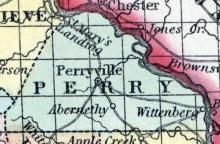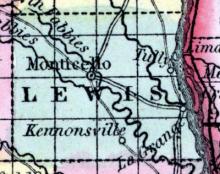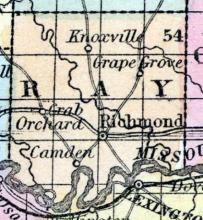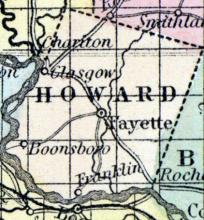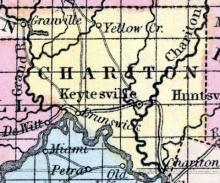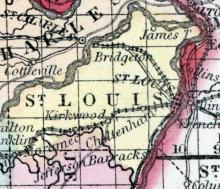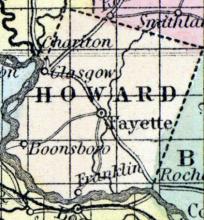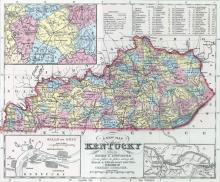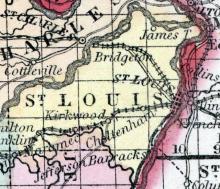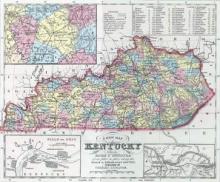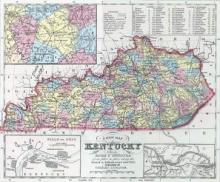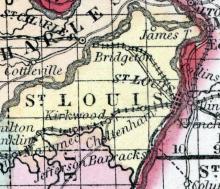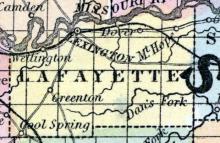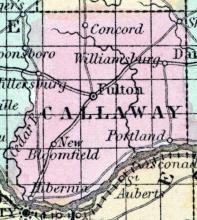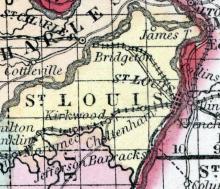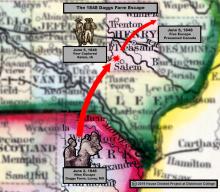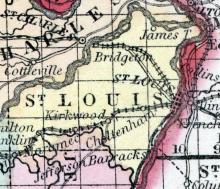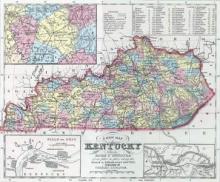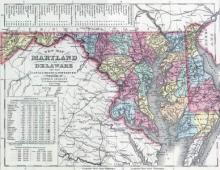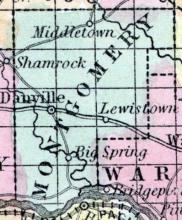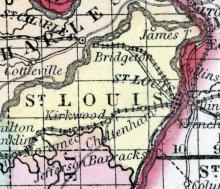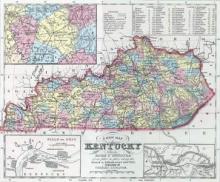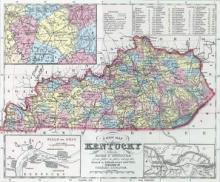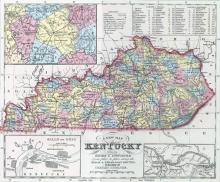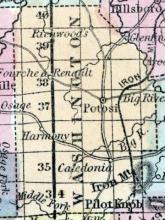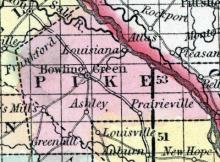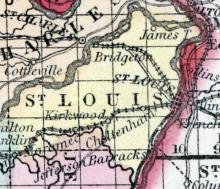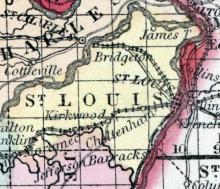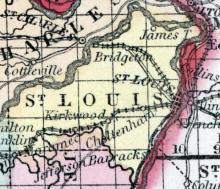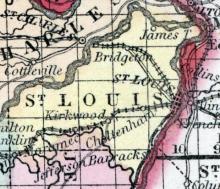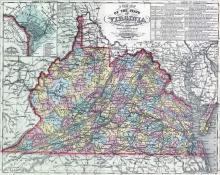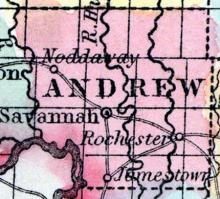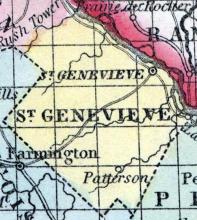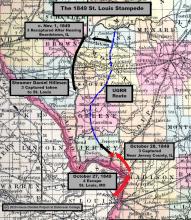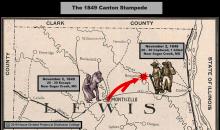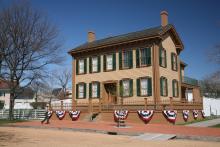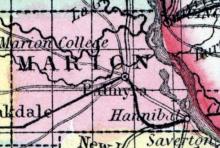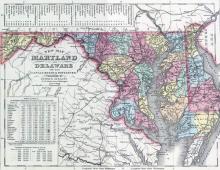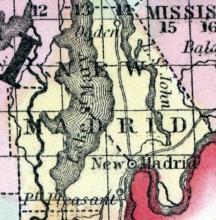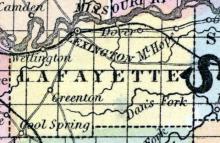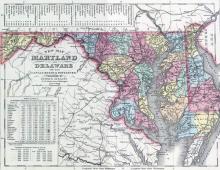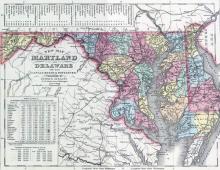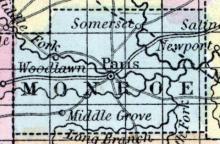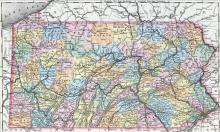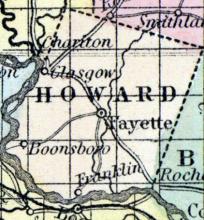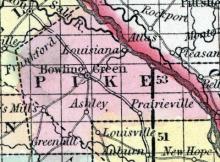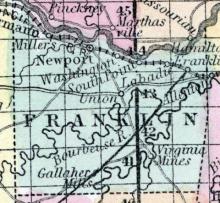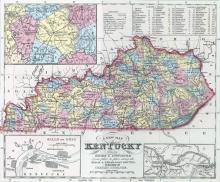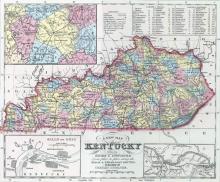On Tuesday, November 3, 1840, an enslaved man named John, around 48 years in age, escaped from Bois Brule Bottom in Perry county, Missouri. His enslaver, F.L. Jones, advertised a $50 reward for his recapture, calling him "an artful fellow and a great rogue."
View All Escapes // 1840s // 1850s // 1860s
Displaying 1 - 50 of 476
On Monday, December 19, 1842, an enslaved man named Jefferson escaped from near Richmond in Ray county. Noting that Jefferson "is a keen shrewd fellow, and will in all probability be furnished with free papers," his enslaver Henry Jacobs advertised a $20 reward for his recapture.
On Saturday night, August 12, 1843, an enslaved man named Simon, aged 25, escaped from a farm three miles south of Fayette in Howard county, Missouri. His enslaver, B.F. Broaddus, advertised a $50 reward for Simon's recapture.
On Saturday night, September 23, 1843, three enslaved men––Clem, Peter (age 20), and Robert (age 18)––escaped from a farm near Salt Creek in Chariton county, Missouri. Their enslaver, G.W. Gauss, suspected the three men "will probably aim to go down on a steamboat," and offered a $30 reward for their recapture.
Four enslaved people escaped from St. Louis in 1844, and successfully reached Chicago. Despite slaveholder James Bissell's efforts to send slave catchers in pursuit, the four freedom seekers' bid for liberty was successful.
On Wednesday, April 28, 1847, a roughly 21-year-old enslaved man named Ben escaped from St. Louis. Ben had formerly been enslaved in Hannibal by M.P. Owsley. His current salveholder, B.W. Alexander, offered a $200 reward for his return.
In mid-May 1847, five to six enslaved people fled from Maysville, Kentucky across the Ohio River to free soil. The Covington, Kentucky Register pointed the finger at members of the Northern Methodist Church. A "distinguished preacher of that denomination" was reportedly seen at the very house where five enslaved people escaped, and around the same time.
A 20-year-old enslaved man named Harry escaped from the steamer St. Paul on Friday afternoon, September 24, 1847. Harry's enslaver, B.F. Thomas, had hired him out to a St. Louis hotel, but since September 6 Harry had been working as fireman aboard the steamboat.
On Sunday, April 23, 1848, an enslaved man named Adrian, aged about 23, escaped from Lexington, Missouri. His enslaver, Thomas Henker, suspected that Adrian was "now in St. Louis, as it is known that he has brothers and sisters living in that place," and advertised a $100 reward for his recapture.
On April 27, 1848, a 26-year-old enslaved carpenter named Matison broke out of the jail at Fulton in Callaway county. The St. Louis slave trading firm White & Tooly advertised $100 for Matison's recapture.
On Thursday, June 1, 1848, an enslaved man named Armstead escaped from St. Louis. His enslaver, William North, suspected that Armstead had escaped along with a recently sold enslaved man "of notorious charachter." North offered $200 for Amstead's recapture.
On Friday evening, June 2, 1848, at least nine enslaved people--John and Mary Walker, their four children, and Sam and Dorcas Fulcher, along with their pregnant daughter Julia--escaped from the Daggs Farm in Luray, Missouri. Their enslaver, Ruel J. Daggs, sent a slave-catching posse in pursuit, led by his son. At first, the runaways received help and shelter at a Quaker-dominated settlement in Salem, Iowa.
On Saturday afternoon, June 24, 1848, a 37-year-old enslaved woman named Dicy escaped from St. Louis. Slaveholder Elizabeth Walker predicted that Dicy would change her clothes and likely would seek out her husband, a free African American man named Andy. Her husband had left St. Louis several days before Dicy's escape, and Walker seethed that Andy had "doubtless made arrangements for her escape."
On Saturday night, August 5, 1848, a group ranging in number from 50 to 80 enslaved people fled from near Lexington, Kentucky. Accompanying the group was a white man named Patrick Doyle. The freedom seekers were overtaken and recaptured after a violent confrontation. Reports later emerged suggesting that Doyle had instigated the escape with the plan to betray the freedom seekers and pocket the reward.
On Tuesday night, September 5, 1848, a group of 12 to 20 enslaved people fled from two slaveholders in Baltimore county, Maryland. Six were claimed by slaveholder J.T.H. Worthington. According to reports, the group succeeded in crossing into Pennsylvania, despite being pursued by white Marylanders.
On Saturday, September 30, 1848, a 20-year-old enslaved man named Jonas escaped from St. Louis. Reports placed Jonas on board the steamer Swiss Boy, bound for Illinois. Jonas's enslaver, James McFadin, advertised a $200 reward for his recapture.
In the fall of 1848, a 35-year-old enslaved man named Joe escaped from a farm seven miles south of Danville in Montgomery county, Missouri. His enslaver, Richardson Culpepper, advertised a $100 reward for Joe's recapture.
On Tuesday, October 3, 1848, a 30-year-old enslaved man named Jack Holliday escaped from slaveholder W.G. Clark's sawmill north of St. Louis. Clark advertised a $150 reward for Holliday's recapture.
Armed with free passes, "about forty" enslaved people were planning a stampede from Woodford county, Kentucky on Saturday night, October 7, 1848. But the plot was discovered when one enslaved person confessed, and the escape "frustrated" before it could begin.
Throughout late October 1848, multiple "stampedes" occurred from near Maysville, Kentucky. One "stampede" saw "some four or five" enslaved people escape, evidently heading for Ripley, Ohio, and "several others" were also missing. Meanwhile, three enslaved people from neighboring Montgomery county were captured near Ripley before they were able to cross the Ohio river.
On Saturday night, December 23, 1848, two enslaved people, a man and a woman, escaped from their enslaver in Maysville, Kentucky. Reports suspected that "several others have left the city and county."
On Monday, March 26, 1849, an enslaved couple, 40-year-old Aaron and 30-year-old Ann, escaped from Potosi in Washington county, Missouri. Their enslaver, Michael Pierpont, advertised a $200 reward for their recapture.
Around April 1, 1849, an enslaved man named Tom, aged 16, escaped from a farm near the town of Ashley in Pike county, Missouri. His enslaver, John J. Lewis, offered a $100 reward for Tom's recapture.
On Monday night, May 7, 1849, an 18-year-old enslaved woman named Caroline, and a 24-year-old enslaved woman named Martha, escaped from their enslavers in St. Louis. A $300 reward was offered for their recapture.
Facing imminent separation, John and Lucinda Henderson, with their two children in tow, escaped from St. Louis. With the aid of vigilance operatives near Alton, the Hendersons reached Chicago.
On the morning of August 14, 1849, a 16-year-old enslaved boy named George Ben (or Ben George) escaped from St. Louis. His enslaver, A.G. Switzer, advertised a $50 reward for his recapture.
On Wednesday, July 18, 1849, an enslaved child named Joseph White escaped from St. Louis. His enslaver, J. Small, advertised a $50 reward for his recapture.
Around the beginning of September 1849, a group of freedom seekers, heavily armed "with bowie-knives, dirks, &c.," fled from Jefferson county, Virginia, heading north towards Pennsylvania. Two miles north of Wolfsville, Maryland, the group was overtaken by slave catchers. A violent confrontation ensued, and it "required a strong force" to re-enslave the freedom seekers.
On Saturday night, September 29, 1849, an enslaved man named Henry, around 21-22 years in age, escaped from the town of Savannah in Andrew county, Missouri. His enslaver, William R. King, offered a $75 reward for Henry's recapture.
On Saturday night, October 27, 1849, two enslaved men, Emmanuel and Bill, escaped from Ste. Genevieve county, Missouri. Slaveholding judge William James offered a $50 reward for Emmanuel's recapture, and slaveholder Kavin Byrne advrtised a $50 reward for Bill's recapture.
On Saturday night, October 27, 1849, a group of six enslaved people escaped from St. Louis for "parts unknown," according to the local newspaper. The flight came in the wake of a series of recent group escapes, leading many in the city to suspect "that they have been stampeded." This appears to be the very first newspaper reference to a slave stampede from Missouri.
In early November 1849, somewhere between 35 and 50 enslaved people around Canton in Lewis County, Missouri, led by a woman named Lin and a man known as Miller's John, planned a stampede for freedom but were betrayed and cornered before they could cross the Mississippi River. There was a violent shootout that left at least one dead and resulted in dozens of newspaper articles across the nation.
Up to 14 freedom seekers escaped from St. Louis and passed through Springfield, Illinois in January 1850, where they received help from Jameson Jenkins, a free black neighbor of Abraham Lincoln's.
On Tuesday night, February 12, 1850, an enslaved man named Hilliard Small, aged about 25, escaped from the farm of slaveholder Lewis Bryan near Palmyra, Missouri. The same night, Small was accused of setting fire to the livery stable of Bradley & Lee in downtown Palmyra. B.B. King, sheriff for Marion county, advertised a $150 reward for Small's recapture.
Sometime in June 1850, a group of 16 enslaved people fled from Baltimore county, Maryland, journeying to Shrewsbury, Pennsylvania. But slaveholders offered a hefty $2,000 reward for the freedom seekers' recapture, and they were discovered hiding in the outhouse of a farm near Shrewsbury. The freedom seekers were re-enslaved and taken back to Maryland.
An enslaved person, who was not identified by name, escaped from New Madrid county, Missouri around 1850 and sought refuge at Sparta, Illinois. When the slaveholder, a man named Sherwood, discovered the escapee's location, Sherwood dispatched his son and a posse in pursuit. Local anti-slavery activists protected the escapee with threats of force, sending the Missourians returning south empty-handed.
An enslaved man named Moses Johnson escaped from slaveholder Crawford E. Smith in Lafayette county, Missouri on July 4, 1850. Johnson was recaptured by U.S. officers under the 1850 Fugitive Slave Law nearly a year later, in Chicago, in early June 1851. He was released following a rendition hearing before U.S. Commissioner George W. Meeker.
Sometime in early August 1850, seven freedom seekers escaped in concert from Baltimore, Calvert, Montgomery, and Prince George's counties. On Wednesday, August 7, a group of Pennsylvanians observed the freedom seekers at the home of a free black man near Shrewsbury, who was not identified by name, and attempted to trick the runaways with promises of help.
On Sunday night, August 18, 1850, a sizable group ranging in number from 30 to 40 freedom seekers escaped from Prince George's county, Maryland. Their ultimate fate remains unknown.
On Saturday night, September 7, 1850, a 26-year-old enslaved man named Anthony, and a 22-year-old woman named Margaret, escaped from a farm 10 miles south of the town of Florida in Monroe county, Missouri. They took with them a bay mare. Their enslavers, James F. Botts and James Wilfley, advertised a $300 reward for the pair's recapture.
Soon after the passage of the 1850 Fugitive Slave Act, reports described the flight of fugitive slaves from Pittsburgh, Pennsylvania. Most contemporaries believed that these individuals had long since escaped from bondage in the Upper South, and now took flight to avoid re-enslavement under the new federal code.
On Saturday, January 11, 1851, an enslaved man named Oliver escaped from a farm near Fayette in Howard county. His enslaver, Robert W. Baskett, advertised a $200 reward for Oliver's recapture.
On Tuesday, January 21, 1851, an enslaved man named Reuben, approximately 20 years of age, escaped from a farm near Ramsey's Creek in Pike county, Missouri. His enslaver, George Wilson, advertised a $100 reward for Reuben's re-enslavement.
On Sunday, March 30, 1851, an enslaved man named Edmond, aged about 20, escaped from Franklin county, Missouri. His enslaver, Henry W. Hudley, suspected that Edmond was "lurking around" Bredell's old copper works in Franklin county, and advertised a $100 reward for Edmond's recapture.
Throughout late April 1851, a number of "stampedes" were launched from Mason and Nicholas counties, Kentucky. On Sunday night, April 27 alone, more than 14 freedom seekers escaped from around Maysville, while "several" others left Nicholas county during the same week.
Around May 1, 1851, a "stampede" of roughly 20 freedom seekers took place from Lewis county, Kentucky. Among the group was an enslaved mother and her seven children, ranging in age from 25 to 12. However, after crossing the Ohio river the group was recaptured, with a sizable $4,000 reward doled out to the captors. Following their recapture, the mother and her seven children were sold by a Lewis county slaveholder named Fagan for $4,200.

